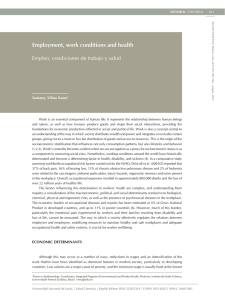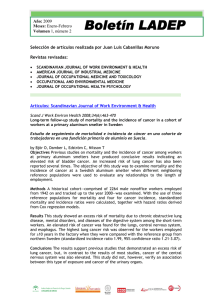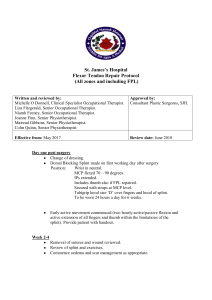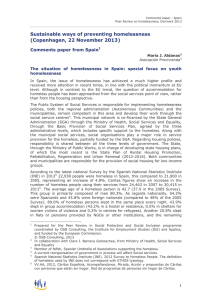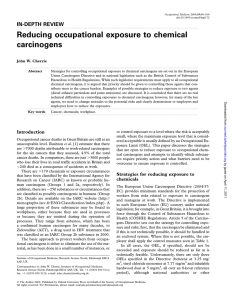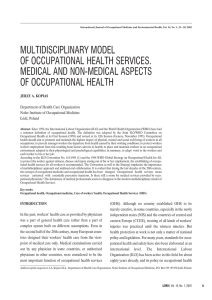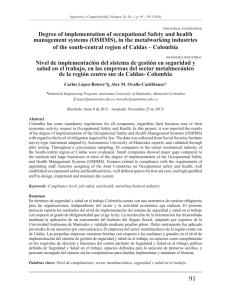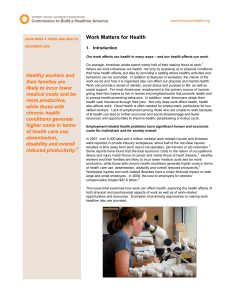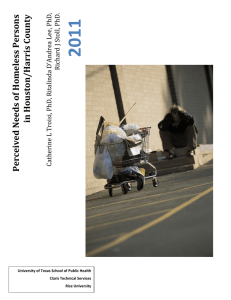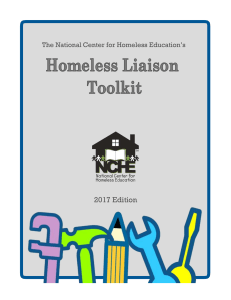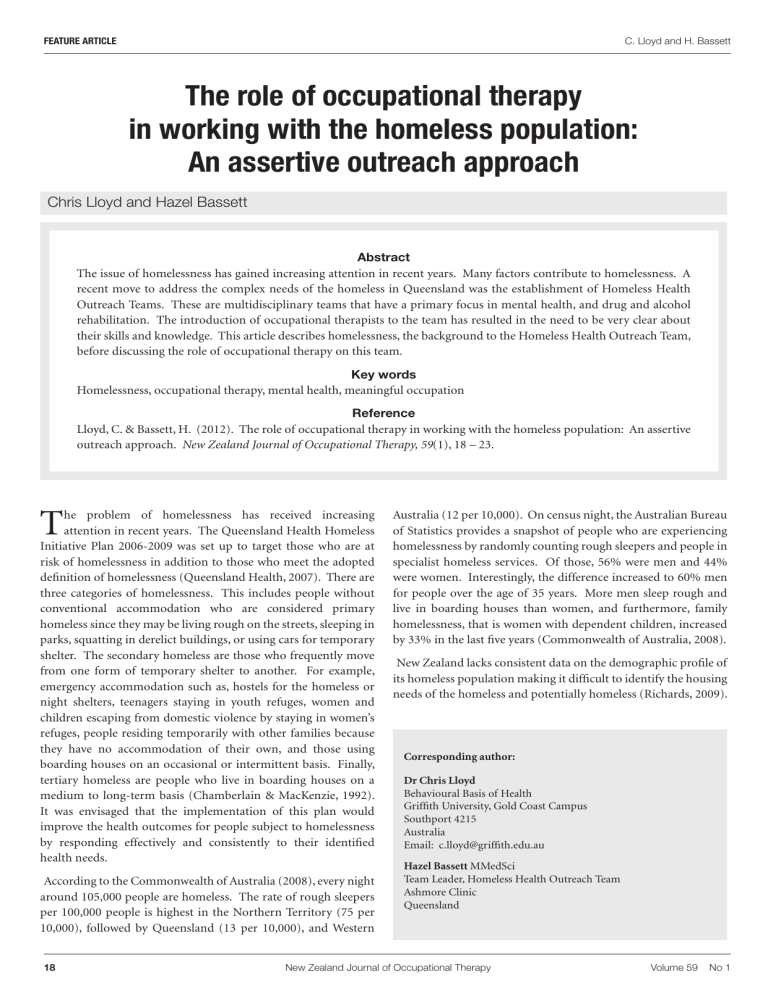
C. Lloyd and H. Bassett FEATURE ARTICLE The role of occupational therapy in working with the homeless population: An assertive outreach approach Chris Lloyd and Hazel Bassett Abstract The issue of homelessness has gained increasing attention in recent years. Many factors contribute to homelessness. A recent move to address the complex needs of the homeless in Queensland was the establishment of Homeless Health Outreach Teams. These are multidisciplinary teams that have a primary focus in mental health, and drug and alcohol rehabilitation. The introduction of occupational therapists to the team has resulted in the need to be very clear about their skills and knowledge. This article describes homelessness, the background to the Homeless Health Outreach Team, before discussing the role of occupational therapy on this team. Key words Homelessness, occupational therapy, mental health, meaningful occupation Reference Lloyd, C. & Bassett, H. (2012). The role of occupational therapy in working with the homeless population: An assertive outreach approach. New Zealand Journal of Occupational Therapy, 59(1), 18 – 23. T he problem of homelessness has received increasing attention in recent years. The Queensland Health Homeless Initiative Plan 2006-2009 was set up to target those who are at risk of homelessness in addition to those who meet the adopted definition of homelessness (Queensland Health, 2007). There are three categories of homelessness. This includes people without conventional accommodation who are considered primary homeless since they may be living rough on the streets, sleeping in parks, squatting in derelict buildings, or using cars for temporary shelter. The secondary homeless are those who frequently move from one form of temporary shelter to another. For example, emergency accommodation such as, hostels for the homeless or night shelters, teenagers staying in youth refuges, women and children escaping from domestic violence by staying in women’s refuges, people residing temporarily with other families because they have no accommodation of their own, and those using boarding houses on an occasional or intermittent basis. Finally, tertiary homeless are people who live in boarding houses on a medium to long-term basis (Chamberlain & MacKenzie, 1992). It was envisaged that the implementation of this plan would improve the health outcomes for people subject to homelessness by responding effectively and consistently to their identified health needs. According to the Commonwealth of Australia (2008), every night around 105,000 people are homeless. The rate of rough sleepers per 100,000 people is highest in the Northern Territory (75 per 10,000), followed by Queensland (13 per 10,000), and Western 18 Australia (12 per 10,000). On census night, the Australian Bureau of Statistics provides a snapshot of people who are experiencing homelessness by randomly counting rough sleepers and people in specialist homeless services. Of those, 56% were men and 44% were women. Interestingly, the difference increased to 60% men for people over the age of 35 years. More men sleep rough and live in boarding houses than women, and furthermore, family homelessness, that is women with dependent children, increased by 33% in the last five years (Commonwealth of Australia, 2008). New Zealand lacks consistent data on the demographic profile of its homeless population making it difficult to identify the housing needs of the homeless and potentially homeless (Richards, 2009). Corresponding author: Dr Chris Lloyd Behavioural Basis of Health Griffith University, Gold Coast Campus Southport 4215 Australia Email: [email protected] Hazel Bassett MMedSci Team Leader, Homeless Health Outreach Team Ashmore Clinic Queensland New Zealand Journal of Occupational Therapy Volume 59 No 1 The role of occupational therapy in working with the homeless population: An assertive outreach approach However, it is likely the demographic profile conforms to other western countries. According to Richards (2009), New Zealand is in a position to address the basic need for shelter of its people, regardless of age, gender, ethnic origin, religion or sexuality. At present, there is no single Government department that has a statutory responsibility for the homeless or for coordinating services. It has been found that homelessness has a low profile as a political issue (Richards, 2004). There are many causes of homelessness. People who are at risk of homelessness tend to face many difficulties, for example, domestic and family violence, mental health problems, drug and alcohol addiction, and poverty. When faced with social pressure such as job loss, eviction, poor health, or relationship breakdown, people without support, skills, or personal resilience, or who have limited capacity due to their age or disability, may become homeless. With limited resources, it is likely these vulnerable people will remain homeless for a long period of time (Commonwealth of Australia, 2008). Homelessness has a direct impact on health. Homeless people, particularly rough sleepers, have a higher rate of serious morbidity compared to the general population. They tend to experience a range of health problems including, infections, inflammatory skin conditions, skin infestations, respiratory illness, physical trauma, adverse effects of illicit drugs, and/or mental health issues (Wright & Tomkins, 2006). They are also responsible for a disproportionate use of judicial, social and health care resources. Often the only health care that homeless people receive is through the emergency department in a hospital (Turnbull, Muckle, & Masters, 2007). The history of occupational therapy is grounded in the relationship between health and occupation (Finlay, 2004). Occupational therapists address occupational performance areas related to productive activities such as work, activities of daily living, socialization, and leisure (Barnekow & Pickens, 2011). People who are homeless face many social and economic barriers that impact on their ability to fully engage in occupations in the community. They are excluded from many basic aspects of life such as education, employment, housing, social networks, and health care. Since survival becomes their main aim, meaningful occupations are directed towards surviving on the streets. A key goal of occupational therapy is to assist clients who feel excluded, isolated, hopeless or worthless to once again become a part of their social world by ensuring the client’s environment and social networks are as supportive as possible (Finlay, 2004). This approach is endorsed by mental health recovery and empowerment-oriented frameworks which posit that increased participation in meaningful occupations endorses health and well-being, mainly through the development of a personal and social identity (Eklund, 2011). The homeless health outreach team In Queensland, the Homeless Health Outreach Teams (HHOT) are multidisciplinary teams, consisting of occupational therapy, medical, nursing, social work, psychology, welfare, and alcohol Volume 59 No 1 FEATURE ARTICLE and drug clinicians. These teams have a primary focus in mental health, alcohol, and drugs. They are encouraged to actively work in partnership with other professionals including general practitioners (GP), non-government organisations (NGO), local councils and other government agencies, such as housing and Centrelink (government pension scheme). The goal of the team is to assist in the development of a holistic approach to service delivery. A recovery approach is utilised in recognition of the fact that clients have the greatest knowledge and expertise regarding their needs and service requirements. A recovery approach identifies personal goals and how best to achieve them within a given situation. Initially, a comprehensive assessment is undertaken before collaborating with the person to develop an individual treatment plan. The service delivery model has three key components: assertive outreach, case management, and collaborative response (Queensland Health, 2007). Assertive outreach Assertive outreach is essential to reach and engage with clients who are homeless. More importantly, it brings the service into community settings including shelters, food vans, parks or other homeless agencies. A primary case manager is allocated to each client and with their consent, the case manager collaborates with others service providers to ensure continuity of care and comprehensive treatment. As health care needs and other basic needs are often interrelated, co-ordination with other service providers is essential. There has been an emphasis on the development of networks and referral pathways between Queensland Health, NGOs, and other service providers to reduce barriers to service access. The HHOT employs 20.5 multidisciplinary staff who work extended hours to cover seven days per week, 365 days per year. The regular day shift has a team of clinicians at work, while the evenings and weekends are covered by two staff members. Each day begins with intake. That is to say, new referrals are presented to the team. Once a person is accepted for intervention, and the preliminary assessment is completed, a case manager and a backup person are appointed. During the week, work is often organised around service provision e.g. crisis accommodation, and sources of free food. A person referred to the team, must meet criteria for primary or secondary homelessness and has either a mental health problem and/or a substance use issue. Common diagnoses include depression, schizophrenia, substance use, bipolar affective disorder or personality disorder. On average, the HHOT team has approximately 46 referrals per month (Lloyd & Bassett, 2010). It is recommended that service support should be provided as long as required (Queensland Health, 2007). Many clients are only eligible for a short period of time. Others, with more complex needs, may be followed up for an extended period of time. Some clients are transient and so are lost to follow up. If they are known to be transients, information is readily accessible to other HHOTs in Queensland and to other agencies and services throughout the country. Approximately 60 clients are case managed, but others who are not registered as service users can be seen at the assertive New Zealand Journal of Occupational Therapy 19 C. Lloyd and H. Bassett FEATURE ARTICLE outreach service in their community. Team members have a primary responsibility for an average of five or six clients and usually have responsibility for five or six more as back up. Individual treatment plans identify the bio/psycho/social issues that need to be addressed (see Table 1) as well as the client’s goals, and the intervention strategies to achieve the goals. These plans are drawn up by an occupational therapist in collaboration with clients. Occupational therapy role with the homeless There is an unmet need for occupational therapists working with the homeless and those who do, face multiple challenges (Grandisson, Mitchell-Carvalho, Tang, & Korner-Bitensky, 2009). The role has been addressed in a number of occupational therapy Journals. For the most part, these articles have addressed the perspectives of occupational therapists working in homeless shelters (Griner, 2006; Herzberg, Ray, & Swenson Miller, 2006; Munoz, Dix, & Reichenbach, 2006; Schultz-Krohn, 2004; Tryssenaar, Jones, & Lee, 1999). Little has been published about the role of occupational therapy working with the homeless using an assertive community treatment model (Lloyd & Bassett, 2010; Murtagh, Lloyd, & Bassett, 2010). The Assertive Community Treatment Model focuses on providing intensive case management within the client’s own environment (Krupa et al., 2004). The literature, which is mostly from the USA, Canada and UK, has also addressed employment interventions (Kannenberg & Boyer, 1997), independent living skills (Davis & Kutter, 1998; Helfrich & Fogg, 2007), the Model of Human Occupation (Kavanagh & Fares, 1995), Occupational Adaptation (Johnson, 2006), needs assessment (Finlayson, Baker, Rodman, & Herzberg, 2002), functional needs of homeless people (Mosby, 1996), student fieldwork (Heubner & Tryssenaar, 1996; Totter & Pratt, 2001), goal setting (Scultz-Krohn, Drnek, & Powell, 2006), and assessing the occupational performance priorities of people who are homeless (Munoz, Garcia, Lisak, & Reichenbach, 2006). What is notable about the literature is that it predominantly deals with occupational therapists working in homeless shelters. Evident in the American literature, this has meant that there was little information available to guide an occupational therapist working with an assertive outreach team. Grandisson et al. (2009) argued that occupational therapists have a unique approach to the provision of client-centred care. Developing a role for occupational therapy with persons who are homeless requires an understanding of their individual needs and occupational performance issues. Table 1 Team Treatment Plan Issue Objectives Ways this will be achieved Medication Currently on a depot. She has a previous history of non compliance and becomes unwell when not medicated. She benefits from fortnightly depot injections to keep her mental state stable. To continue with fortnightly administration of depot medication. To be aware of early warning signs. Fortnightly appointments with HHOT to receive depot injection. Develop a list of early warning signs and look at a relapse prevention plan. Weight management To weigh her every fortnight when she receives her depot injection so we can monitor any weight gain. Referral to a local walking group. Referral to a local gym. HHOT clinicians to take scales to depot appointments to weigh her. Monitor any increase in weight. Accompany her to the gym to provide support. Health promotion To provide her with ongoing education around healthy eating and physical activity. Ongoing education around the importance of maintaining a healthy lifestyle. Assist her in getting motivated to participate further in activities such as walking on a regular basis. Goals Assist her to develop a list of goals. To support her in working towards achieving the short and long term goals she has set for herself. Regular review of goals. Evaluate progress every three months. Monitoring m/s and risk To continue to monitor her m/s and risk during routine appointments. Monitor m/s, assess for early warning signs. Ongoing monitoring of risk at each appointment. 20 New Zealand Journal of Occupational Therapy Volume 59 No 1 The role of occupational therapy in working with the homeless population: An assertive outreach approach Role of occupational therapists in the team Occupational therapists in HHOT work in a variety of both generic and occupational therapy specific roles. Like other members of the team, they complete consumer assessments, risk assessments, mental state examinations, formulate a recovery plan (see Table 2) and engage clients in case management. In a more discipline specific role, occupational therapists also complete functional and financial assessments, which are followed up by making recommendations to the Department of Housing regarding an individual’s ability to maintain a tenancy and/or regarding supports that may be required. Occupational therapy functional assessments may include a combination of interview, practical tasks, and standardized assessments to assist with identifying meaningful occupational roles. The identified roles may include those with which the client is currently engaged and/ or those the client has identified as being important for the future. Occupational therapists also assist a client to re-establish major life roles such as family roles, including parenting. An example FEATURE ARTICLE of this would be to restore contact with a child by assisting with access and encouraging parenting skills. If a client who has been homeless is allocated accommodation by the Department of Housing, then an occupational therapist may be called in to assist the person to acquire basic house management skills. For example, activities of daily living such as personal care, budgeting, shopping, food preparation, cooking, leisure time planning, keeping the house clean and tidy, and using a washing machine. People who have experienced homelessness benefit from this input. In the belief that purposeful use of time and energy, gives life meaning, occupational therapists working with the homeless aim to assist clients to maximize strengths and build skills to participate effectively in everyday activities. Furthermore, engaging in meaningful occupations helps clients to improve their mental health and overall sense of wellbeing. Of importance when dealing with people who have been marginalized and excluded is a focus on assisting them to establish routines, and to find Table 2 Mental Health Services Recovery Plan Ways in which staff/others help me to achieve my objectives Issue Objectives Contact with children Short term: To have fortnightly phone contact with my two oldest children who live in NSW. Fortnightly p/cs when I top up my phone. Long term: To work towards weekend overnight stays with my two youngest children within the next 12 months. To visit my oldest two children who live in NSW within the next 12 months. Continue with fortnightly contact with children to show commitment. Discuss with Aunty and arrange overnight stays. Purchase a sofa bed for the children to sleep on when staying over. Save money towards the trip to NSW. Discuss with children’s legal guardian. Work towards a specific date. Household items Short term: To purchase further items for my unit, including a sofa bed and a rug. Save money. Apply for a Centrelink loan when eligible. Health Short term: To get my weight checked once a fortnight when I receive my depot to monitor weight gain. HHOT clinician who administers the depot are to ensure they take the scales to check weight. To make an appointment with the women’s health clinic to get a complete woman’s health check up within the next three months. HHOT case manager to assist in making the appointment and providing transport for the first appointment for support. Long term: To give up drinking alcohol so I can work towards increasing contact with my children, save money and be healthier. To continue to liaise with HHOT staff regarding same. Wants to do this on her own terms. Discuss with GP medications to assist with cravings. To give up smoking. Discuss with GP. Short term and long term: To save $20.00 each fortnight. Stick to a budget. Do not withdraw money from savings. Finances Volume 59 No 1 New Zealand Journal of Occupational Therapy 21 C. Lloyd and H. Bassett FEATURE ARTICLE satisfaction in carrying out daily occupations. These tasks draw upon core occupational therapy skills and models of practice such as the Model of Human Occupation (Kielhofner & Burke, 1985). Reflection on outcomes Establishing the role of occupational therapy within the team has been an ongoing challenge. For instance, staff attendance at outreach venues requires co-ordination and flexibility, particularly when a client presents as unwell and requires extra input to assess the problem. Models of practice that include the environment require occupational therapists to consider the impact of the environment with reference to meaningful occupations. There is also an element of risk involved as outreach occurs both early in the morning and late at night. This can lead to issues arising around intoxication, aggression, and other unknown elements that may impact upon the safety of team members. Furthermore, working shift work is a relatively new expectation for occupational therapists. In using generic mental health skills, they also have to try and maintain their identity as occupational therapists and to demonstrate the relevance of their discipline specific skills. Overall, occupational therapists on the team have risen to these challenges while demonstrating the unique value of occupational therapy intervention for this client group, to the other team members. Lloyd, Bassett, and King (2010) conducted a study to determine whether the HHOTs could operate within an established framework. They found that the teams operated in the middle range on the fidelity measure with higher fidelity in human resources and nature of services such as, developing community skills in vivo rather than in an office, in organisational boundaries. This provided the background for other research projects on specific aspects of treatment for clients such as, examining pet ownership among the homeless (Slatter, Lloyd, & King, in press). It would be of interest to survey other teams who work with homeless clients to find out whether they employ occupational therapists and, if they have a discipline specific focus. Conclusion Working with the homeless is an opportunity for occupational therapists to develop their role in a relatively new field of practice. The occupational therapy focus on function, purposeful activity, life roles and the development of individual capacity lends itself well to this specialised field. The authors contend that occupational therapists have a key role to play in addressing the functional needs of homeless people and assisting them to take up meaningful occupational roles. The inclusion of occupational therapists on this team has enabled a holistic approach to service provision that has been of benefit to the people who access the services. From a professional perspective, occupational therapists working within the Homeless Health Teams have been able to improve their generic skills while utilising occupational therapy specific skills. 22 References Barnekow, K. & Pickens, N. D. (2011). Introduction to occupation and cooccupation. In: C. Brown & V. C. Stoffel (Eds.), Occupational therapy in mental health: A vision for participation, pp. 637-647 Philadelphia: F.A. Davis. Chamberlain, C., & MacKenzie, D. (1992). Understanding contemporary homelessness: Issues of definition and meaning. Australian Journal of Social Issues, 27(4), 274- 297. Commonwealth of Australia. (2008). The road home. A national approach to reducing homelessness. Canberra: Commonwealth of Australia. Davis, J., & Kutter, C. J. (1998). Independent living skills and posttraumatic stress disorder in women who are homeless: Implications for future practice. American Journal of Occupational Therapy, 52(1), 39-44. Eklund, M. (2011). Occupation and wellness. In: C. Brown & V. C. Stoffel (Eds.), Occupational therapy in mental health: A vision for participation. pp. 649-658. Philadelphia: F.A. Davis Company. Finlay, L. (2004). The practice of psychosocial occupational therapy, (3rd ed.). Cheltenham, UK: Nelson Thornes. Finlayson, M., Baker, M., Rodman, L., & Herzberg, G. (2002). The process and outcomes of a multimethod needs assessment at a homeless shelter. American Journal of Occupational Therapy, 56(3), 313-321. Grandisson, M., Mitchell-Carvalho, M., Tang, V., & Korner-Bitensky, N. (2009). Occupational therapists’ perceptions of their role with people who are homeless. British Journal of Occupational Therapy, 72(11), 491498. Griner, K. R. (2006). Helping the homeless: An occupational therapy perspective. Occupational Therapy in Mental Health, 22(1), 49-61. Helfrich, C. A., & Fogg, L. F. (2007). Outcomes of a life skills intervention for homeless adults with mental illness. Journal of Primary Prevention, 28(3/4), 313-326. Herzberg, G. L., Ray, S. A., & Swenson Miller, K. (2006). The status of occupational therapy addressing the needs of people experiencing homelessness. Occupational Therapy in Health Care, 20(3/4), 1-8. Heubner, J., & Tryssenaar, J. (1996). Development of an occupational therapy practice perspective in a homeless shelter: A fieldwork experience. Canadian Journal of Occupational Therapy, 63(1), 24-32. Johnson, J. A. (2006). Describing the phenomenon of homelessness through the theory of Occupational Adaption. Occupational Therapy in Health Care, 20(3/4), 63-80. Kannenberg, K., & Boyer, D. (1997). Occupational therapy evaluation and intervention in an employment program for homeless youths. Psychiatric Services, 48(5), 631-633. Kavanagh, J., & Fares, J. (1995). Using the Model of Human Occupation with homeless mentally ill clients. British Journal of Occupational Therapy, 58(10), 419-422. Kielhofner, G., & Burke, J. P. (1985). Components and determinants of human occupation. In: G. Kielhofner (Ed.). A Model of Human Occupation: Theory and application, pp. 12-36. Baltimore: Williams & Wilkins. Krupa, T., Eastabrook, S., Beattie, P., Carriere, R., McIntyre, D., & Woodman, R. (2004). Challenges faced by service providers in the delivery of assertive community treatment. Canadian Journal of Community Mental Health, 23(1), 115-124. Lloyd, C., & Bassett, H. (2010). The role of an Australian Homeless Health Outreach Team: Background, part I. International Journal of Therapy and Rehabilitation, 17, 290-295. Lloyd, C., Bassett, H., & King, R. (2010). The Queensland Homeless Health Outreach Teams: Do they use the Assertive Community Treatment (ACT) model? Advances in Mental Health, 9(2), 130-137. Mobsby, I. (1996). A guide to the responsibilities of occupational therapists and their managers in regard to homeless people who use their services. British Journal of Occupational Therapy, 59(12), 557-560. Munoz, J. P., Dix, S., & Reichenbach, D. (2006). Building productive roles: Occupational therapy in a homeless shelter. Occupational Therapy in Health Care, 20(3/4), 167-187. New Zealand Journal of Occupational Therapy Volume 59 No 1 The role of occupational therapy in working with the homeless population: An assertive outreach approach Munoz, J. P., Garcia, T., Lisak, J., & Reichenbach, D. (2006). Assessing the occupational performance priorities of people who are homeless. Occupational Therapy in Health Care, 20(3/4), 135-148. Murtagh, L., Lloyd, C., & Bassett, H. (2010). The role of an Australian homeless health outreach team: A case study, Part II. International Journal of Therapy and Rehabilitation, 17(8), 436-443. Queensland Health, (2007). Queensland Health Homeless Initiative: Statewide Guidelines, Processes and Protocols. Brisbane: Queensland Health. Richards, S. (2009). Homelessness in Aotearoa: Issues and recommendations. Wellington: Regional Public Health. Schultz-Krohn, W. (2004). The meaning of family routines in a homeless shelter. American Journal of Occupational Therapy, 58(5), 531-542. Schultz-Krohn, W., Drnek, S., & Powell, K. (2006). Occupational therapy intervention to foster goal setting skills for homeless mothers. Occupational Therapy in Health Care, 20(3/4), 149-166. FEATURE ARTICLE Slatter, J., Lloyd, C., & King, R. (in press). Homelessness and companion animals: More than just a pet? British Journal of Occupational Therapy. Totten, C., & Pratt, J. (2001). Innovation in fieldwork education: Working with members of the homeless population in Glasgow. British Journal of Occupational Therapy, 64(11), 559-563. Tryssenaar, J., Jones, E. J., & Lee, D. (1999). Occupational performance needs of a shelter population. Canadian Journal of Occupational Therapy, 6(4), 188-196. Turnbull, J., Muckle, W., & Masters, C. (2007). Homelessness and health. Canadian Medical Association Journal, 177(9), 1065-066. Wright, N. M. J., & Tompkins, C. N. E. (2006). How can health services effectively meet the health needs of homeless people? British Journal of General Practice, 56(525), 286-293. SPECIAL NEEDS Changing and Medical Tables NZ manufactured! Medical Technologies New website: www.ergosolmedical.com Wall Mount Tables – Showering stainless steel battery pack – Changing mains powered Mobile/Treatment Tables – Large high/low range – Easy maneuverability – Showering & changing grades Contact Amtech Medical now: 0800 268 324 [email protected] www.amtech.co.nz Volume 59 No 1 New Zealand Journal of Occupational Therapy 23 Copyright of New Zealand Journal of Occupational Therapy is the property of New Zealand Association of Occupational Therapists and its content may not be copied or emailed to multiple sites or posted to a listserv without the copyright holder's express written permission. However, users may print, download, or email articles for individual use.
